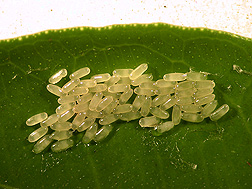Tracking Diaprepes
Since its arrival in 1964, the Diaprepes root weevil, Diaprepes abbreviatus, has been a major contributor to the decline of Florida’s citrus industry. Able to feed on more than 200 host plant species, the weevil has managed to spread across the southern two-thirds of the state and throughout the citrus-producing areas of peninsular Florida.
Also spotted in Texas in 2000, this dangerous invasive pest showed up in 2005 on ornamental palms in Orange County, California, where it is feared the weevil could do great damage because of the state’s favorable climate.
But there is some good news. ARS researchers, led by entomologist Steve Lapointe with the Subtropical Insects Research Unit in Fort Pierce, Florida, have discovered that the distribution of Diaprepes root weevils in Florida is limited by temperature. This finding could be vital to figuring out how best to predict and limit the weevil’s spread.
Lapointe found that adult female weevils stop producing eggs at 59˚F and that the eggs are highly susceptible to cold—they died when exposed to 53˚F for 4.2 days. This explains why Diaprepes hasn’t been able to make it to the northern third of Florida.
|
|
Using this knowledge, Lapointe and his team worked with scientists from the USDA Animal and Plant Health Inspection Service (APHIS) Center for Plant Health Science and Technology to develop probability maps. The maps describe the current Diaprepes distribution in Florida and predict areas susceptible to infestation in other states. They’re based on data generated by the joint North Carolina State University-APHIS Pest Forecasting System.
The maps use a combination of soil and air temperatures to delineate the current distribution of both Diaprepes root weevils and helpful egg-attacking parasitoids. The parasitic wasps Quadrastichus haitiensis, from Puerto Rico, and Aprostocetus vaquitarum, from the Dominican Republic, have both been introduced into Florida to control the weevil and are already considered established in southern Florida. The maps also show which portions of Texas, California, and Arizona are most susceptible to new establishments of the weevil. This information will help to guide survey and control efforts in those states.
The successful establishment but limited geographic spread of egg parasitoids in Florida spurred a search for new biological control agents, including two newly introduced wasp species: Fidiobia dominica from Dominica and Haeckeliania sperata from St. Lucia. It’s too soon to know whether or not they will establish. Lapointe believes their success will depend on year-round availability of prey egg masses. While D. abbreviatus egg masses and adults can be found throughout the year in southern Florida and the Caribbean, colder weather can greatly reduce their numbers. Alternative food sources would have to be provided during these periods.
“Having these probability maps and understanding the effect of climate on both the pest and its natural enemies gives us a huge boost in predicting where Diaprepes may end up,” says Lapointe. “With these tools, we can figure out the best way to manage the eradication efforts currently under way in California and Texas.”—By Alfredo Flores, Agricultural Research Service Information Staff.
This research is part of Crop Protection and Quarantine, an ARS National Program (#304) described on the World Wide Web at www.nps.ars.usda.gov.
Stephen L. Lapointe is in the USDA-ARS Subtropical Insects Research Unit, 2001 South Rock Rd., Fort Pierce, FL 34945; phone (772) 462-5914, fax (772) 462-5986.
"Tracking Diaprepes" was published in the May/June 2007 issue of Agricultural Research magazine.








